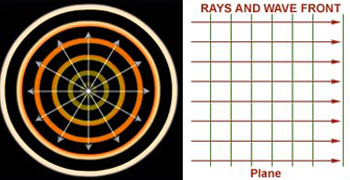 Rays and wave front
Every point on the wave front acts as a source of secondary wavefronts.
Rays and wave front
Every point on the wave front acts as a source of secondary wavefronts.
Christiaan Huygens, a contemporary of Newton, is most remembered, for his idea about wave theory of light. He assumed that light wave is a transverse wave consisting of crests and troughs. Waves from a source of light propagate outwards. All points concentric to the source will have crests (or troughs) at the same distance. The curve where a disturbance is same is known as a wave front. For example, close to a light source, the wave fronts will be spherical; but if the light source is very far away, the wave fronts will be planar.
Huygens' principle states that every point on a propagating wave front serves as the source of spherical secondary wavelets, such that the wave front at some later time is the envelope of these wavelets. If the propagating wave has a frequency f, and is transmitted through the medium at a speed v, then the secondary wavelets will have the same frequency and speed. From this simple principle, Huygens was able to derive the laws of reflection and refraction.